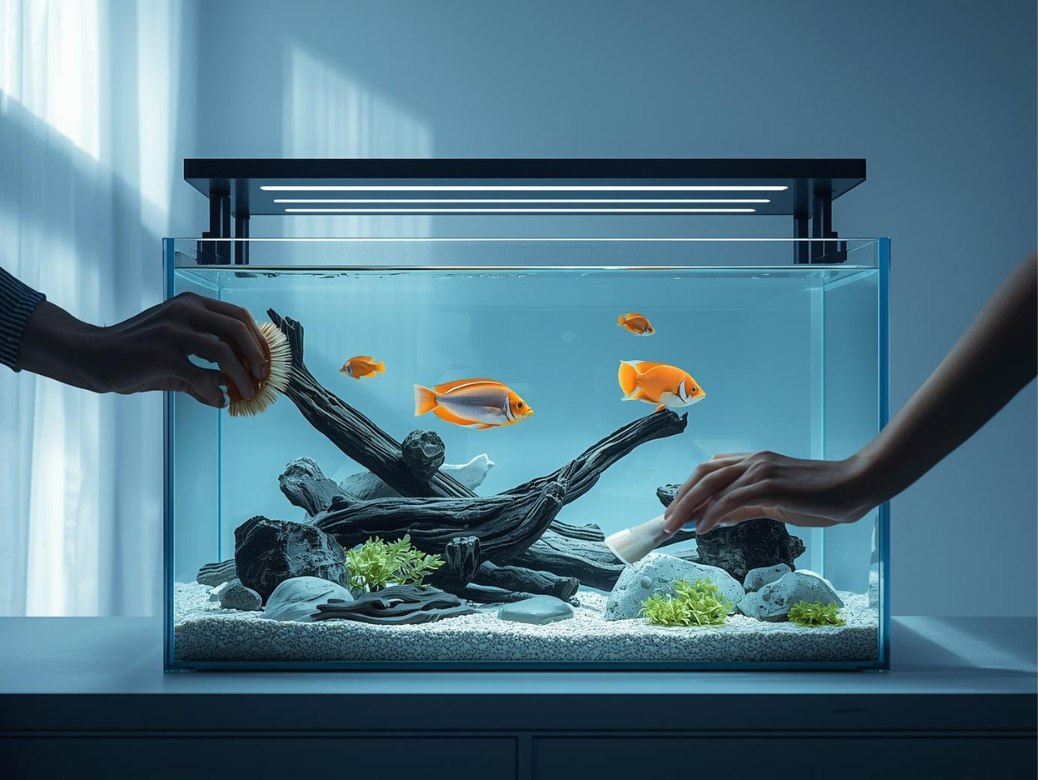
You’ve probably Googled how to clean aquarium decorations before only to find the same vague advice: “Take everything out and scrub it.”
But what if your driftwood is glued into the aquascape? Or your live plants are intertwined with a stone arch you can’t move without tearing roots?
That’s where this guide changes everything.
We’ll go deep into in-tank cleaning workflows, algae-specific strategies, and safety tips for delicate fish, shrimp, and live plants.
Think of this as your step-by-step playbook for keeping your aquarium stunning without ever tearing it apart.
- What You’ll Learn
- 1. Understanding the Goal: Clean, Not Sterile
- 2. Know Your Material: The Right Way to Clean Each Type
- 3. Algae Type → Targeted In-Tank Solution Map
- 4. Tools That Actually Work (And What to Avoid)
- 5. Safe Cleaning Around Sensitive Livestock
- 6. Emergency Rescue: Heavy Algae Without Removing Décor
- 7. Peroxide and Chemical Spot-Treatment Guide
- 8. The Routine Maintenance Checklist
- 9. Bonus: Your Visual Decision Matrix (Printable)
- 10. FAQs: Cleaning Aquarium Decorations the Smart Way
- Final Thoughts
What You’ll Learn
- The safe, step-by-step process for cleaning each decoration type in place
- How to identify algae types and pick targeted, gentle solutions
- This section explains which tools are best for different surfaces and identifies those that may cause scratches.
- How to protect your shrimp, snails, and live plants during cleaning
- Expert-tested peroxide and dosing methods for tough grime
- A downloadable cleaning checklist and maintenance schedule
1. Understanding the Goal: Clean, Not Sterile
When you’re learning how to clean aquarium decorations, remember the goal isn’t to sterilize. A little biofilm and algae actually help with biological balance.
“ You’re aiming for visibly clean, biologically safe, and aesthetically clear.”
So instead of harsh scrubbing or bleach, you’ll use controlled, gentle methods that protect the living ecosystem while keeping your décor looking crisp.
2. Know Your Material: The Right Way to Clean Each Type
Here’s the truth: you can’t treat all decorations the same. Porous terracotta reacts differently than glazed ceramic, and driftwood absorbs everything like a sponge.
Plastic Ornaments & Synthetic Plants
- Use a soft toothbrush or foam pad to lift algae without dislodging gravel.
- For stubborn green spots, use a hydrogen peroxide-dipped cotton swab (3%)—spot treat for 30–60 seconds, then rinse in tank water.
- Avoid metal tools; they scratch easily.
Driftwood
- Gently brush using a silicone spatula or soft-bristle brush.
- If you see black beard algae (BBA), apply a few drops of diluted peroxide with a pipette directly on the patch.
- Don’t overdo it—driftwood absorbs chemicals fast.
Porous Terracotta or stone.
- Use a grout brush to reach crevices.
- For hair algae, gently swirl your magnetic scrubber near the surface—the movement loosens strands safely.
- Never scrub dry; always under water to avoid dust release.
Glazed Ceramic or Resin Décor
- Wipe gently with a foam pad or microfiber cloth.
- These materials resist algae but can show calcium stains—spot clean with a few drops of vinegar solution, then rinse immediately.
Live Rock (Marine Tanks)
- Use a turkey baster or powerhead to blow off debris.
- Avoid scraping; the rock’s micro-organisms are part of your filtration system.
- For cyanobacteria, increase flow and reduce direct light instead of scrubbing.
3. Algae Type → Targeted In-Tank Solution Map
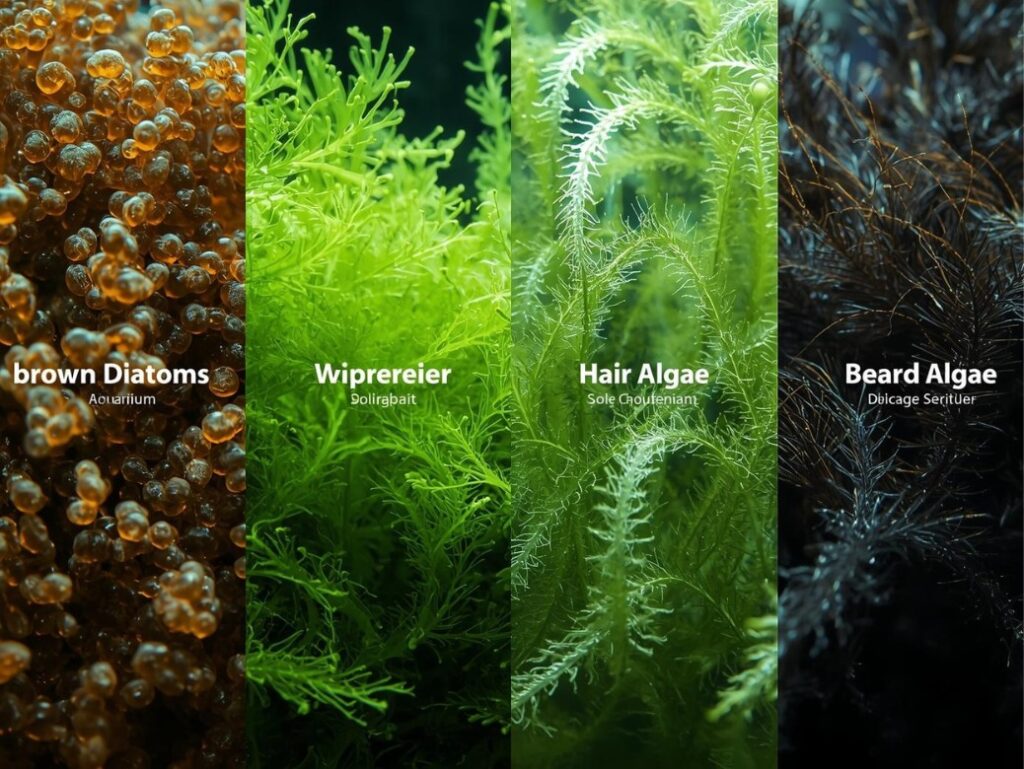
Knowing what you’re fighting saves you hours of guesswork.
Here’s your algae decoding guide:
| Algae Type | Appearance | Targeted Fix (In-Tank) |
| Diatoms | Brown film, easy to wipe | Boost light duration slightly; wipe gently with foam pad |
| Green Film Algae | Soft green layer | Use magnetic scrubber; increase live plant density |
| Hair Algae | Stringy threads | Twist toothbrush to spool it off; spot treat peroxide |
| Black Beard Algae (BBA) | Dark, fuzzy tufts | Peroxide spot treat (max 1ml/10gal daily) or add Siamese algae eater |
Each type needs a different rhythm — the beauty of this method is you’ll clean smarter, not harder.
4. Tools That Actually Work (And What to Avoid)
Let’s be real — half the internet tells you to use a toothbrush. But not all brushes are equal.
Here’s what actually works in the tank:
| Tool | Best For | Pros | Cautions |
| Magnetic scrubber | Glass, acrylic walls | Hands-free, efficient | Some can scratch acrylic |
| Silicone spatula | Driftwood, rock | Gentle, reusable | Not for tight crevices |
| Grout brush | Terracotta, textured surfaces | Great reach | Too firm for glass |
| Toothbrush (soft) | Plastic plants, corners | Cheap, precise | Replace often |
| Foam pad | Smooth ceramics | Scratch-free | Wears down fast |
Pro Tip: Test each tool on a spare piece of décor before using it on your main setup.
5. Safe Cleaning Around Sensitive Livestock
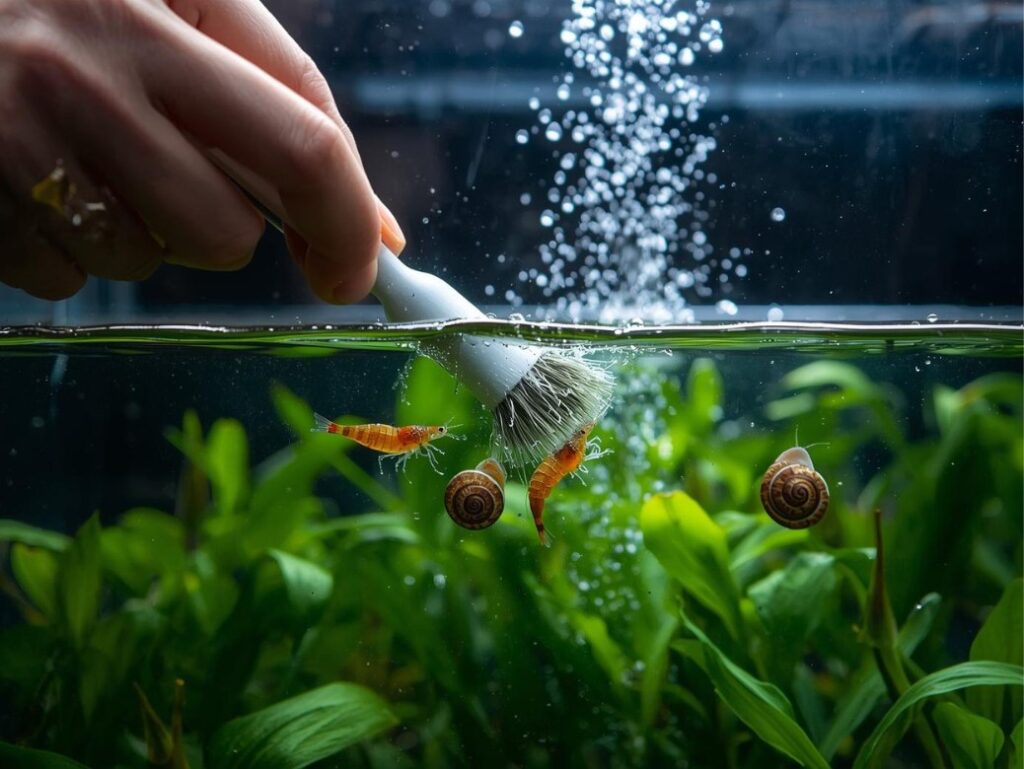
This is where most guides fail. Shrimp, snails, and corals can react badly to disturbed algae and chemicals.
Here’s how to protect them:
- Turn off filters and powerheads during cleaning to avoid debris spread.
- Spot clean small sections instead of the whole tank at once—reduces stress.
- Use airline tubing to siphon loose particles mid-clean.
- Avoid peroxide overdosing. Max safe in-tank dose: 1 ml of 3% peroxide per 10 gallons per day.
Keep an eye on O₂ bubbles—too much fizz means you’ve gone too far.
6. Emergency Rescue: Heavy Algae Without Removing Décor
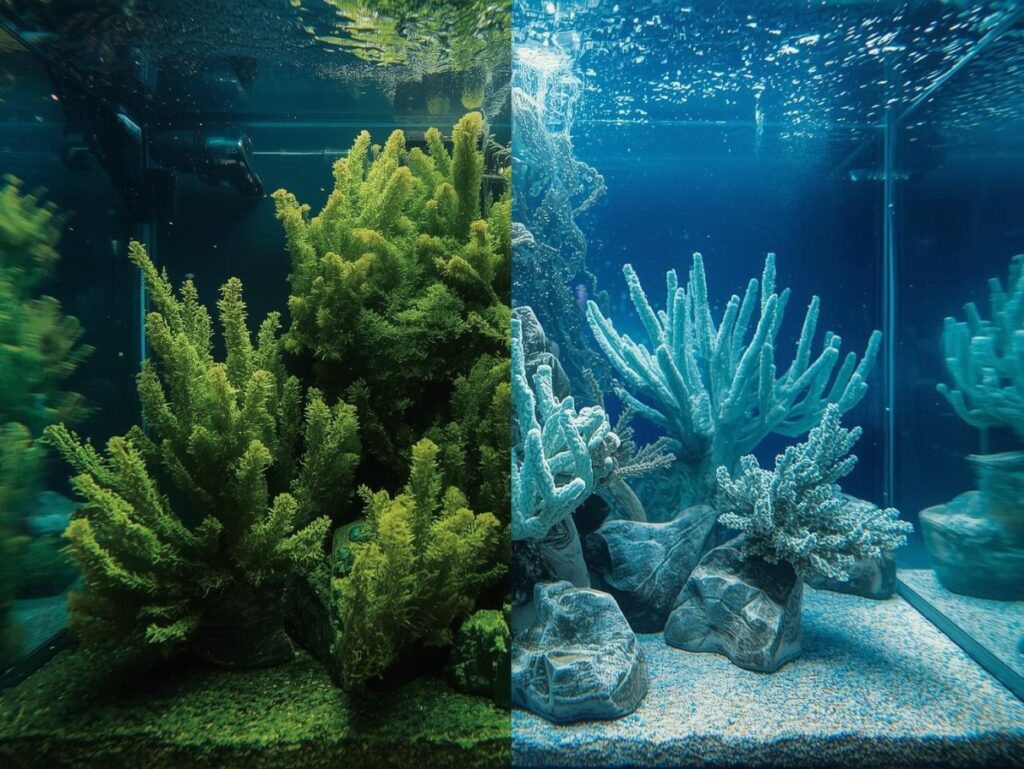
Sometimes your decorations are part of the landscape, and you can’t remove them.
Here’s what to do:
- Temporarily lower water level for direct access.
- Use a pipette to apply peroxide only on algae spots. Wait 2–3 minutes.
- Refill the tank slowly to avoid shocking fish with oxygen spikes.
- Add a small activated carbon pouch to your filter for 24 hours to absorb residues.
Result? Crystal-clear décor, zero relocation stress.
7. Peroxide and Chemical Spot-Treatment Guide
Hydrogen peroxide works — but dosing varies wildly online.
Here’s a safe, tested framework:
| Tank Size | Max Daily Dose (3%) | Use Case |
| 10 gal | 1 ml | Light algae on ornaments |
| 20 gal | 2 ml | Moderate algae or driftwood |
| 40 gal | 4 ml | Black beard algae patches |
Always pre-dilute peroxide with tank water (1:4 ratio) before spot-treating. Never pour it directly into the tank.
8. The Routine Maintenance Checklist
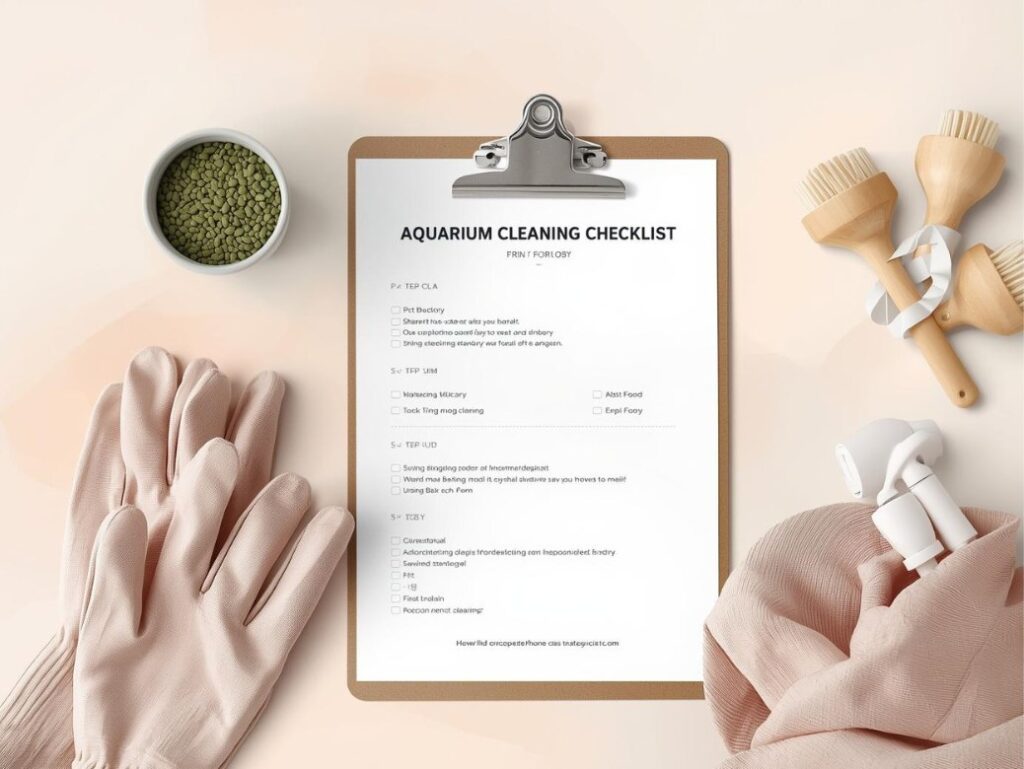
Consistency beats emergency scrubbing every time.
Weekly:
- Wipe visible algae from plastic décor and ornaments.
- Trim plants to reduce shadow algae zones
Monthly:
- Brush driftwood and stones lightly.
- Check for calcium buildup on ceramic pieces
Quarterly:
- Spot-treat hard algae
- Refresh magnetic scrubber pads
Bookmark this schedule—your aquarium will look magazine-ready year-round.
9. Bonus: Your Visual Decision Matrix (Printable)
Problem: Green algae on plastic coral
→ Fix: Toothbrush scrub + live plant boost
Problem: BBA on driftwood
→ Fix: Diluted peroxide pipette, 1 ml/10 gal
Problem: Hair algae on terracotta pot
→ Fix: Grout brush sweep + reduced feeding
10. FAQs: Cleaning Aquarium Decorations the Smart Way
Q1. Can I clean algae while fish are inside?
Yes, if you clean small sections at a time and use non-toxic tools. Avoid sudden peroxide surges.
Q2. How often should I clean aquarium decorations?
Light cleaning weekly, deeper spot treatments monthly. Avoid over-cleaning—biofilm helps stability.
Q3. What’s the safest chemical for in-tank cleaning?
Diluted hydrogen peroxide (3%) is safe in small, controlled doses. Vinegar should be used only on removable items.
Q4. Will peroxide harm shrimp or snails?
Not if you stay under 1 ml/10 gallons and use spot application only. Always watch for stress signs.
Q5. Can LED lighting help reduce algae?
Absolutely. Balanced, dimmable LEDs prevent excess algae growth and highlight your décor beautifully.
Final Thoughts
Knowing how to clean aquarium decorations without removing them isn’t just a convenience hack; it’s a sustainable way to care for your underwater world.
By respecting each material, recognizing algae types, and protecting your tiny tank residents, you’ll create a balanced ecosystem that looks pristine and feels alive.
“ Because the best aquariums aren’t the cleanest; they’re the healthiest.”



